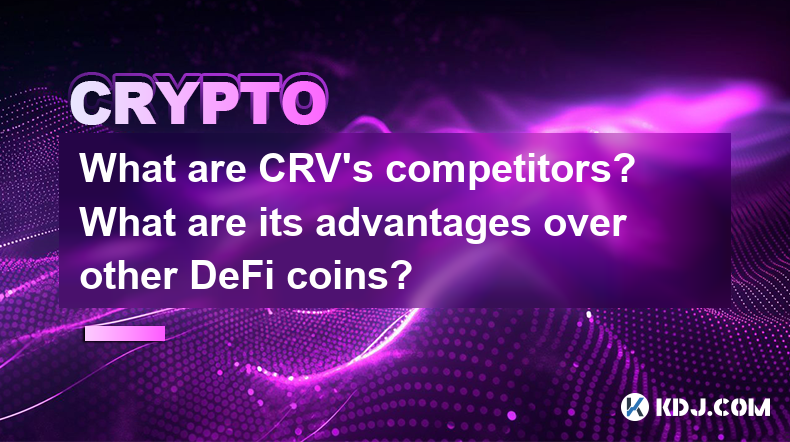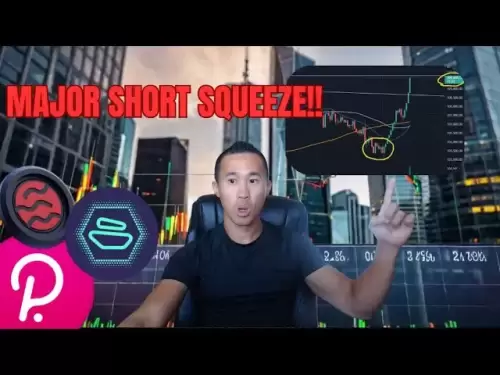-
 Bitcoin
Bitcoin $109,459.7682
2.44% -
 Ethereum
Ethereum $2,598.6052
6.29% -
 Tether USDt
Tether USDt $1.0003
0.00% -
 XRP
XRP $2.2734
3.95% -
 BNB
BNB $661.4886
1.58% -
 Solana
Solana $155.4825
4.35% -
 USDC
USDC $0.9999
-0.02% -
 TRON
TRON $0.2838
1.04% -
 Dogecoin
Dogecoin $0.1740
8.25% -
 Cardano
Cardano $0.6047
9.04% -
 Hyperliquid
Hyperliquid $40.2302
6.50% -
 Sui
Sui $2.9863
10.05% -
 Bitcoin Cash
Bitcoin Cash $509.5786
0.60% -
 Chainlink
Chainlink $13.8156
6.03% -
 UNUS SED LEO
UNUS SED LEO $9.0142
0.69% -
 Avalanche
Avalanche $19.0337
8.68% -
 Stellar
Stellar $0.2438
5.17% -
 Toncoin
Toncoin $2.9012
3.59% -
 Shiba Inu
Shiba Inu $0.0...01210
6.20% -
 Litecoin
Litecoin $90.0882
7.05% -
 Hedera
Hedera $0.1597
8.53% -
 Monero
Monero $326.3340
2.88% -
 Polkadot
Polkadot $3.6365
9.32% -
 Bitget Token
Bitget Token $4.6162
2.72% -
 Dai
Dai $1.0001
0.00% -
 Ethena USDe
Ethena USDe $1.0002
-0.01% -
 Uniswap
Uniswap $7.6403
10.47% -
 Pepe
Pepe $0.0...01060
12.03% -
 Aave
Aave $281.3664
7.56% -
 Pi
Pi $0.4992
1.76%
What are CRV's competitors? What are its advantages over other DeFi coins?
CRV, Curve Finance's token, excels in stablecoin trading with low slippage and fees, offering governance and high yields, setting it apart from competitors like Uniswap and Balancer.
May 02, 2025 at 07:28 pm

CRV, the native token of Curve Finance, has emerged as a significant player in the decentralized finance (DeFi) ecosystem. As the DeFi space grows, understanding CRV's competitors and its advantages over other DeFi coins is crucial for investors and users alike. This article delves into these aspects, providing a detailed analysis of CRV's position in the market.
Overview of CRV and Curve Finance
Curve Finance is a decentralized exchange liquidity pool on Ethereum designed for extremely efficient stablecoin trading. The platform's native token, CRV, is used to govern the Curve DAO and incentivize liquidity providers. Curve Finance has gained popularity due to its low slippage and fees, making it a preferred choice for stablecoin swaps.
Major Competitors of CRV
In the DeFi space, CRV faces competition from various platforms and tokens that offer similar services. Some of the notable competitors include:
Uniswap (UNI): Uniswap is a decentralized exchange that allows users to swap a wide range of ERC-20 tokens. While Uniswap is versatile, it often has higher slippage for stablecoin trades compared to Curve.
Balancer (BAL): Balancer is another automated market maker (AMM) that allows users to create liquidity pools with multiple tokens. It offers more flexibility than Curve but may not be as efficient for stablecoin swaps.
SushiSwap (SUSHI): SushiSwap is a fork of Uniswap that offers additional features like staking and yield farming. It competes with Curve in terms of liquidity provision but may not be as optimized for stablecoin trading.
Compound (COMP): Compound is a lending protocol that allows users to lend and borrow cryptocurrencies. While not a direct competitor in terms of trading, it competes with Curve in the broader DeFi ecosystem by offering yield opportunities.
Advantages of CRV Over Other DeFi Coins
Despite the competition, CRV has several advantages that set it apart from other DeFi coins:
Specialization in Stablecoin Trading: Curve Finance is specifically designed for stablecoin swaps, which results in lower slippage and fees compared to general-purpose AMMs like Uniswap. This specialization makes CRV particularly attractive for users focused on stablecoin transactions.
Efficient Liquidity Pools: Curve's liquidity pools are designed to maintain a balance between different stablecoins, ensuring that the pools remain efficient even during high volatility. This efficiency is a significant advantage over platforms like Balancer, which may struggle with maintaining balance in multi-token pools.
Governance and Incentives: CRV holders can participate in the governance of Curve DAO, giving them a say in the platform's development and future direction. Additionally, Curve offers attractive incentives for liquidity providers, which can lead to higher yields compared to other platforms.
Integration with Other DeFi Protocols: Curve Finance has strong integration with other DeFi protocols, such as Yearn Finance and Convex Finance. These integrations enhance the utility of CRV and provide users with more opportunities to earn yields.
Detailed Comparison with Uniswap (UNI)
To provide a more in-depth understanding, let's compare CRV with one of its major competitors, Uniswap (UNI):
Trading Efficiency: Curve's focus on stablecoin swaps results in lower slippage and fees. For example, swapping USDT for USDC on Curve typically incurs lower costs than on Uniswap. This makes Curve the preferred choice for users who frequently trade stablecoins.
Liquidity Provision: Curve's liquidity pools are designed to handle stablecoins effectively, ensuring that the pools remain balanced and efficient. In contrast, Uniswap's liquidity pools can experience higher impermanent loss due to the volatility of the tokens being traded.
User Experience: Curve's interface is streamlined for stablecoin trading, making it user-friendly for those specifically interested in stablecoin swaps. Uniswap, while versatile, may be more complex for users who only need to trade stablecoins.
Token Utility: CRV offers governance rights and incentives for liquidity providers, which can be more attractive than UNI's governance model. UNI holders can vote on proposals, but the incentives for liquidity provision on Uniswap may not be as compelling as those on Curve.
Detailed Comparison with Balancer (BAL)
Another important comparison is with Balancer (BAL), which offers more flexibility in creating liquidity pools:
Pool Flexibility: Balancer allows users to create custom pools with up to eight tokens, providing more flexibility than Curve's stablecoin-focused pools. However, this flexibility can lead to less efficiency in stablecoin trading.
Trading Fees: Curve's focus on stablecoins results in lower trading fees for these specific swaps. Balancer's fees can be higher due to the complexity and potential volatility of its multi-token pools.
Liquidity Management: Curve's liquidity pools are designed to automatically rebalance stablecoins, ensuring that the pools remain efficient. Balancer's pools may require more active management to maintain balance, which can be a disadvantage for users seeking passive income.
Token Utility: CRV provides governance rights and attractive incentives for liquidity providers, similar to BAL. However, the incentives on Curve are often more focused and beneficial for stablecoin liquidity providers.
Detailed Comparison with SushiSwap (SUSHI)
SushiSwap is another competitor that offers additional features like staking and yield farming:
Additional Features: SushiSwap offers staking and yield farming opportunities, which can attract users looking for more than just trading. Curve, while focused on efficient trading, integrates with other protocols to provide similar yield opportunities.
Trading Efficiency: Similar to Uniswap, SushiSwap may have higher slippage and fees for stablecoin trades compared to Curve. Users focused on stablecoin swaps may prefer Curve for its efficiency.
Liquidity Incentives: SushiSwap offers incentives for liquidity providers, but these may not be as targeted towards stablecoin liquidity as Curve's incentives. Curve's focus on stablecoin liquidity can result in higher yields for those specific pools.
Token Utility: SUSHI holders can participate in governance and earn rewards through staking and yield farming. CRV holders also have governance rights and can earn rewards through liquidity provision, but the focus on stablecoin liquidity can make CRV more attractive for those specific use cases.
Detailed Comparison with Compound (COMP)
While Compound is not a direct competitor in terms of trading, it competes with Curve in the broader DeFi ecosystem:
Lending and Borrowing: Compound focuses on lending and borrowing, offering users the ability to earn interest on their crypto assets. Curve, on the other hand, focuses on efficient trading and liquidity provision, which can be more attractive for users interested in stablecoin swaps.
Yield Opportunities: Both platforms offer yield opportunities, but they are structured differently. Compound's yield comes from lending and borrowing, while Curve's yield comes from liquidity provision and trading fees. Users may prefer Curve if they are more interested in trading and liquidity provision.
Token Utility: COMP holders can participate in governance and earn rewards through lending and borrowing. CRV holders also have governance rights and can earn rewards through liquidity provision, but the focus on stablecoin liquidity can make CRV more attractive for those specific use cases.
Integration with Other Protocols: Curve has strong integration with other DeFi protocols, enhancing its utility and providing users with more opportunities to earn yields. Compound also integrates with other protocols, but its focus on lending and borrowing may not be as appealing to users interested in trading and liquidity provision.
Frequently Asked Questions
Q: How does CRV's governance model work?
A: CRV holders can participate in the governance of Curve DAO by voting on proposals that affect the platform's development and future direction. This includes decisions on fee structures, new pool additions, and other operational aspects. Voting power is proportional to the amount of CRV held, incentivizing users to stake their tokens and participate actively in the governance process.
Q: Can CRV be used on other DeFi platforms?
A: Yes, CRV can be used on other DeFi platforms that integrate with Curve Finance. For example, platforms like Yearn Finance and Convex Finance use CRV to enhance their yield farming strategies. Users can stake CRV on these platforms to earn additional rewards, making it a versatile token within the DeFi ecosystem.
Q: What are the risks associated with holding CRV?
A: Like any cryptocurrency, holding CRV comes with certain risks. These include market volatility, which can lead to significant price fluctuations, and smart contract risks, where vulnerabilities in the Curve Finance protocol could potentially be exploited. Additionally, changes in the governance of Curve DAO could impact the value and utility of CRV. It's important for investors to conduct thorough research and consider these risks before investing.
Q: How can I earn CRV tokens?
A: There are several ways to earn CRV tokens. The primary method is by providing liquidity to Curve's pools, where users can earn trading fees and CRV rewards. Additionally, users can stake their CRV tokens on platforms like Convex Finance to earn additional rewards. Participating in Curve's governance by voting on proposals can also lead to earning more CRV through various incentive programs.
Disclaimer:info@kdj.com
The information provided is not trading advice. kdj.com does not assume any responsibility for any investments made based on the information provided in this article. Cryptocurrencies are highly volatile and it is highly recommended that you invest with caution after thorough research!
If you believe that the content used on this website infringes your copyright, please contact us immediately (info@kdj.com) and we will delete it promptly.
- Meme Coin Mania: Is BTC Bull the Next Big Thing in a Limited Time BTC Bull Run?
- 2025-07-03 12:30:11
- Bitcoin Soars to $109,000: What's Fueling the Crypto Rally?
- 2025-07-03 10:30:13
- Splatterhouse Rocks Retro Scene: A UK Magazine Deep Dive
- 2025-07-03 12:30:11
- Bitcoin, the Senate Bill, and $107K: A Wild Ride on Capitol Hill
- 2025-07-03 12:50:11
- Chainlink's Chart Patterns Hint at a Big Move: Decoding the LINK Price
- 2025-07-03 10:50:12
- Shiba Inu, Solana Uptrend, Bitcoin Breakout: Decoding the Crypto Buzz
- 2025-07-03 10:50:12
Related knowledge

How to customize USDT TRC20 mining fees? Flexible adjustment tutorial
Jun 13,2025 at 01:42am
Understanding USDT TRC20 Mining FeesMining fees on the TRON (TRC20) network are essential for processing transactions. Unlike Bitcoin or Ethereum, where miners directly validate transactions, TRON uses a delegated proof-of-stake (DPoS) mechanism. However, users still need to pay bandwidth and energy fees, which are collectively referred to as 'mining fe...

USDT TRC20 transaction is stuck? Solution summary
Jun 14,2025 at 11:15pm
Understanding USDT TRC20 TransactionsWhen users mention that a USDT TRC20 transaction is stuck, they typically refer to a situation where the transfer of Tether (USDT) on the TRON blockchain has not been confirmed for an extended period. This issue may arise due to various reasons such as network congestion, insufficient transaction fees, or wallet-rela...

How to cancel USDT TRC20 unconfirmed transactions? Operation guide
Jun 13,2025 at 11:01pm
Understanding USDT TRC20 Unconfirmed TransactionsWhen dealing with USDT TRC20 transactions, it’s crucial to understand what an unconfirmed transaction means. An unconfirmed transaction is one that has been broadcasted to the blockchain network but hasn’t yet been included in a block. This typically occurs due to low transaction fees or network congestio...

How to check USDT TRC20 balance? Introduction to multiple query methods
Jun 21,2025 at 02:42am
Understanding USDT TRC20 and Its ImportanceUSDT (Tether) is one of the most widely used stablecoins in the cryptocurrency market. It exists on multiple blockchain networks, including TRC20, which operates on the Tron (TRX) network. Checking your USDT TRC20 balance accurately is crucial for users who hold or transact with this asset. Whether you're sendi...

What to do if USDT TRC20 transfers are congested? Speed up trading skills
Jun 13,2025 at 09:56am
Understanding USDT TRC20 Transfer CongestionWhen transferring USDT TRC20, users may occasionally experience delays or congestion. This typically occurs due to network overload on the TRON blockchain, which hosts the TRC20 version of Tether. Unlike the ERC20 variant (which runs on Ethereum), TRC20 transactions are generally faster and cheaper, but during...

The relationship between USDT TRC20 and TRON chain: technical background analysis
Jun 12,2025 at 01:28pm
What is USDT TRC20?USDT TRC20 refers to the Tether (USDT) token issued on the TRON blockchain using the TRC-20 standard. Unlike the more commonly known ERC-20 version of USDT (which runs on Ethereum), the TRC-20 variant leverages the TRON network's infrastructure for faster and cheaper transactions. The emergence of this version came as part of Tether’s...

How to customize USDT TRC20 mining fees? Flexible adjustment tutorial
Jun 13,2025 at 01:42am
Understanding USDT TRC20 Mining FeesMining fees on the TRON (TRC20) network are essential for processing transactions. Unlike Bitcoin or Ethereum, where miners directly validate transactions, TRON uses a delegated proof-of-stake (DPoS) mechanism. However, users still need to pay bandwidth and energy fees, which are collectively referred to as 'mining fe...

USDT TRC20 transaction is stuck? Solution summary
Jun 14,2025 at 11:15pm
Understanding USDT TRC20 TransactionsWhen users mention that a USDT TRC20 transaction is stuck, they typically refer to a situation where the transfer of Tether (USDT) on the TRON blockchain has not been confirmed for an extended period. This issue may arise due to various reasons such as network congestion, insufficient transaction fees, or wallet-rela...

How to cancel USDT TRC20 unconfirmed transactions? Operation guide
Jun 13,2025 at 11:01pm
Understanding USDT TRC20 Unconfirmed TransactionsWhen dealing with USDT TRC20 transactions, it’s crucial to understand what an unconfirmed transaction means. An unconfirmed transaction is one that has been broadcasted to the blockchain network but hasn’t yet been included in a block. This typically occurs due to low transaction fees or network congestio...

How to check USDT TRC20 balance? Introduction to multiple query methods
Jun 21,2025 at 02:42am
Understanding USDT TRC20 and Its ImportanceUSDT (Tether) is one of the most widely used stablecoins in the cryptocurrency market. It exists on multiple blockchain networks, including TRC20, which operates on the Tron (TRX) network. Checking your USDT TRC20 balance accurately is crucial for users who hold or transact with this asset. Whether you're sendi...

What to do if USDT TRC20 transfers are congested? Speed up trading skills
Jun 13,2025 at 09:56am
Understanding USDT TRC20 Transfer CongestionWhen transferring USDT TRC20, users may occasionally experience delays or congestion. This typically occurs due to network overload on the TRON blockchain, which hosts the TRC20 version of Tether. Unlike the ERC20 variant (which runs on Ethereum), TRC20 transactions are generally faster and cheaper, but during...

The relationship between USDT TRC20 and TRON chain: technical background analysis
Jun 12,2025 at 01:28pm
What is USDT TRC20?USDT TRC20 refers to the Tether (USDT) token issued on the TRON blockchain using the TRC-20 standard. Unlike the more commonly known ERC-20 version of USDT (which runs on Ethereum), the TRC-20 variant leverages the TRON network's infrastructure for faster and cheaper transactions. The emergence of this version came as part of Tether’s...
See all articles

























































































